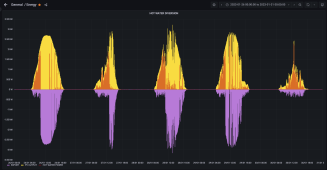wattmatters
Solar Wizard
Like you I investigated a heat pump hot water system but it was not financially rational in our case. They are more effective for anyone with high-ish hot water consumption. Powered mostly via solar PV they use so much less energy (about 1/4) and also operating them in the daytime improves their operating effectiveness (higher coefficient of performance).We have central air, gas furnace for heat and tankless gas for hot water. I did look at a heat pump hot water heater but once you add up the cost of the unit, the permitting and installation cost, the ROI was not there when compared to the tankless gas heater so until this unit dies I won't be looking at an alternatives just yet.
Hot water storage provides a very effective thermal battery where you store energy when it is cheap/abundant to be used later when it is convenient.
We have a resistive element hot water storage tank powered via a dedicated smart solar PV diverter which constantly monitors how much of our solar PV output is being exported to the grid and adjusts the amount of power delivered to the tank depending on the available excess solar PV. Here's a chart from last five days, which has had a combination of nice sunny days and crummy rainy/cloudy days.
It operates on a phase with just 3.6 kW of solar PV. 315 litre tank, 3.6 kW heating element. Two person household.

Yellow = PV output
Purple = Exports to grid
Orange = Energy diverted to hot water storage tank
Can see how on a nice sunny day the main heating cycle finishes during the morning, and the occasional short top up happens in the afternoon.
On crummy solar days the system just keeps operating most of the day, diverting as much energy as it can while always avoiding any grid imports. Because it is a large(ish) tank then if the system does not complete a full charge on a given day it's no big deal, it will catch up the next day. I have the automated off-peak grid energy boost function switched off as I do not want it to boost from off-peak overnight and instead just use available solar PV. But that option is available if I want it to top up from off-peak energy in case a full reheat was not completed. It also has a manual over ride to "heat now" if required.
I tested it earlier this year during a really bad six day stretch in the middle of Winter when it was cloudy the whole time. It still managed to get through with ample hot water supply, and enough heat to ensure no legionella risk.
Energy diverted to hot water on each of those past 5 days:
Code:
Thu: 3.8 kWh
Fri: 3.6 kWh
Sat: 4.6 kWh
Sun: 4.7 kWh
Mon: 3.7 kWhTank heat losses account for ~ 2 kWh of the daily demand.
By way of comparison, an empty tank would require in the vicinity of 16-18 kWh to heat up to 60°C or so.
Our off-peak is not free, it's about to move to ~18-20 c/kWh while our solar feed-in tariff is 7c/kWh, so each kWh diverted saves ~ 11-13c/kWh.
In our case that made it financially rational with diverter cost recovery inside of five years, although our primary motivation was to reduce our import of fossil heavy energy (our grid is dominated by coal fired power).
There are also smart EV chargers which can do similar, adjusting power delivered to the car based on available excess solar PV output. When the time comes for us to change to a BEV then I'll likely install a smart charger for it.
Treating the home like a thermal battery, pre-heating or cooling, is also a good strategy if you have time of use energy charging, provided of course your home is suitable for applying such a strategy. Ours unfortunately has terrible thermal performance and it's not something which works for us. I am working on improving things bit by bit but there's only so much one can do with an older home not constructed with energy efficiency in mind.
We are very used to operating main appliances during solar PV hours. Dishwasher, washing machine, clothes dryer if required (hanging clothes on a line is best) are mostly run during the day, use of timers but mostly just habitual. It wasn't hard to bring the wife along that journey. The pool pump is automated and runs during the day.


